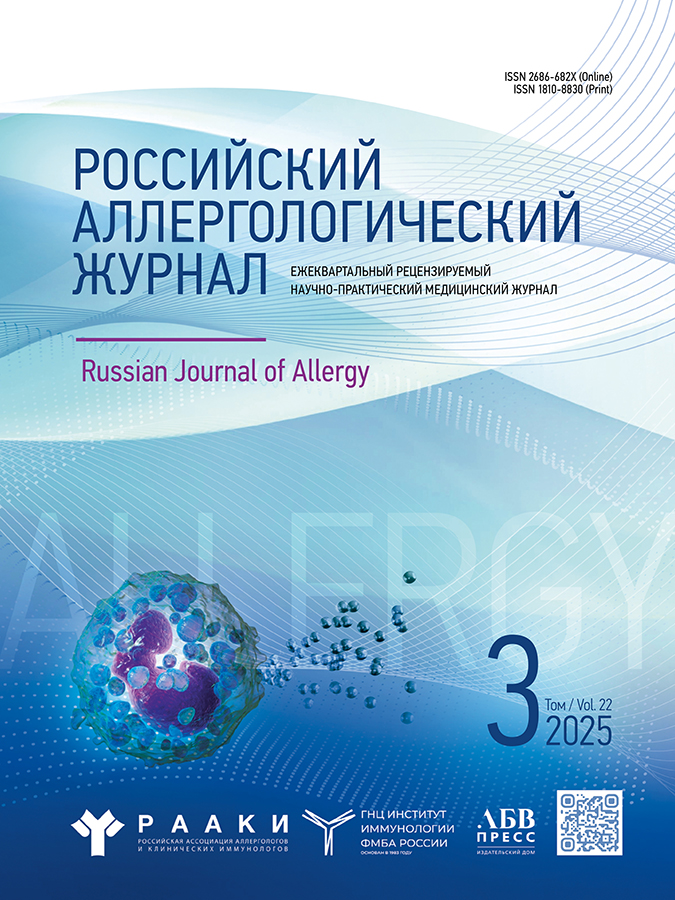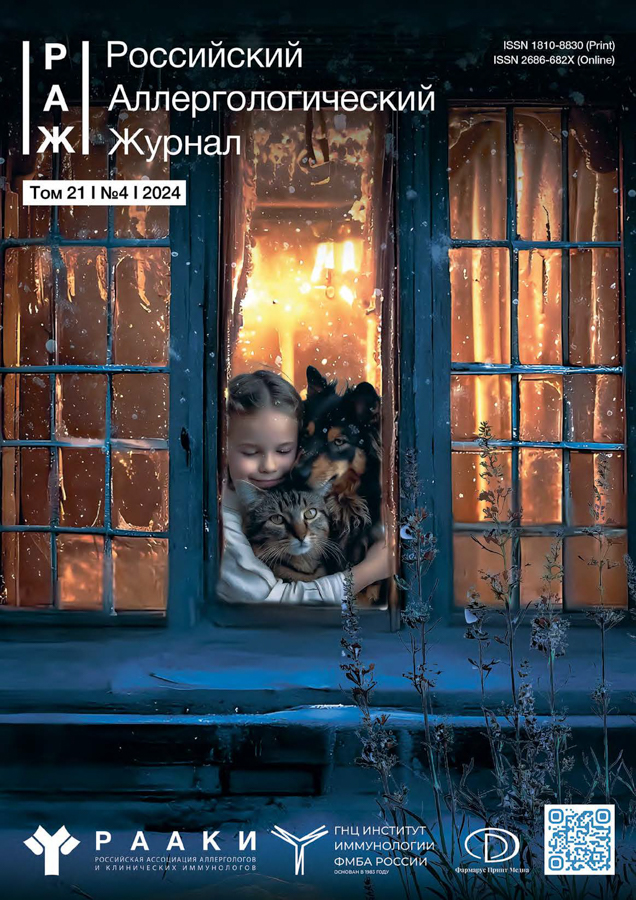Allergy to ceftriaxone and features of cross-reactivity of cephalosporins: an еxperience in specific diagnosis of perioperative anaphylaxis
- Authors: Vorzheva I.I.1, Barachtenko I.V.2, Каrpova A.S.2
-
Affiliations:
- Russian Medical Academy of Continuing Professional Education
- Irkutsk City Clinical Hospital No. 10
- Issue: Vol 21, No 4 (2024)
- Pages: 554-566
- Section: Case reports
- Submitted: 19.05.2024
- Accepted: 13.09.2024
- Published: 28.12.2024
- URL: https://rusalljournal.ru/raj/article/view/16950
- DOI: https://doi.org/10.36691/RJA16950
- ID: 16950
Cite item
Abstract
The development of new effective drugs has contributed to improving the quality of life and increasing its duration, but at the same time has led to an increase in drug hypersensitivity, including one of its most dangerous manifestations – anaphylaxis. Beta-lactams, and among them cephalosporins, and especially ceftriaxone, are among the leaders in the Russian Federation both in terms of frequency of prescription by various specialists, and among the causes of anaphylaxis and mortality associated with it. Anaphylaxis deserves special attention in the perioperative period, when the acute development of a life-threatening condition leads to cancellation of the operation or severe complications. To prevent recurrences of anaphylaxis, it is necessary to determine its specific cause, which often remains unclear, since several drugs are administered simultaneously and, in addition, there is contact with latex, components of medical equipment, etc.
The article describes a specific examination of a patient whose surgery was canceled due to the development of anaphylactic shock in the preoperative period after the administration of ceftriaxone and lidocaine. Using a clinical example, modern approaches to skin and provocation testing for diagnosing drug allergies and selecting the safest beta-lactams are presented, and the interpretation of results of determining the cross-reactivity of cephalosporins with identical R1 side chains, but different R2, is demonstrated. The examination made it possible to establish the cause of anaphylaxis and outline the range of drugs that are safest for the patient, including several beta-lactams as the drugs of choice for perioperative antibiotic prophylaxis and treatment of bacterial infections, if necessary.
Full Text
About the authors
Irina I. Vorzheva
Russian Medical Academy of Continuing Professional Education
Author for correspondence.
Email: vorzheva.irina@gmail.com
ORCID iD: 0000-0002-9405-854X
SPIN-code: 4872-0998
Irkutsk State Medical Academy of Postgraduate Education, Cand. Sci. (Medicine), Assistant Professor
Россия, IrkutskIrina V. Barachtenko
Irkutsk City Clinical Hospital No. 10
Email: irina.barachtenko2011@gmail.com
ORCID iD: 0009-0008-7585-8948
Россия, Irkutsk
Alena S. Каrpova
Irkutsk City Clinical Hospital No. 10
Email: alena_myacheva@mail.ru
ORCID iD: 0009-0005-2880-526X
Россия, Irkutsk
References
- Torres MJ, Dona I. Drug hypersensitivity: Past, present and future. Allergy. 2024;79(3):549–551. doi: 10.1111/all.16050
- Esakova NV, Pampura AN. Drug-induced anaphylaxis: prevalence, risk factors, triggers. Russ J Allergy. 2020;17(1):23–31. (In Russ). doi: 10.36691/RAJ.2020.17.1.002
- Butranova O, Zyryanov S, Gorbacheva A, et al. Drug-Induced Anaphylaxis: National Database Analysis. Pharmaceuticals (Basel). 2024;17(1):90. doi: 10.3390/ph17010090
- Garvey LH, Ebo DG, Mertes PM, et al. An EAACI position paper on the investigation of perioperative immediate hypersensitivity reactions. Allergy. 2019;74(10):1872–1884. doi: 10.1111/ all.13820
- Schroeder MJ, Kraft CT, Janis JE, Kraft MT. Diagnosis and treatment of perioperative allergic complications: a practical review. Plast Reconstr Surg Glob Open. 2024;12(4):e5734. doi: 10.1097/GOX.0000000000005734
- Zhukova DG, Fedenko ES, Yudin AA, Rakhimova OY. The structure of immediate hypersensitivity reactions to drugs in the perioperative period: clinical characteristics, diagnosis and risk assessment. Russ J Allergy. 2014;(6):9–19. (In Russ).
- Yakovlev SV, Briko NI, Sidorenko SV, Protsenko DN. Programma SKAT (Strategy for the Control of Antimicrobial Therapy) in the provision of inpatient medical care: Russian clinical guidelines. Moscow, 2018. Pp. 1–156. (In Russ).
- Vlasova AV, Smirnova EV, Tenovskaya TA, et al. Protocol for Perioperative and Post-exposure Antibiotic Prophylaxis at the State Budgetary Healthcare Institution “Morozovskaya Children’s City Clinical Hospital of Moscow Healthcare Department”. City Healthсare. 2021;2(2):46–64. (In Russ). doi: 10.47619/2713-2617.zm.2021.v2i2;46-64
- Akselrod BA, Menshikh NV, Dymova OV, et al. Intraoperative immediate hypersensitivity reactions in cardiac surgery. Russ J Cardiol Cardiovasc Surg. 2019;12(6):550–556. (In Russ). doi: 10.17116/kardio201912061550.
- Khrapov KN, Khryapa АА, Vartanova IV, et al. A clinical case of anaphylactic shock development after anesthesia induction. Messenger of Anesthesiology and Resuscitation. 2021;18(2):85–96. (In Russ). doi: 10.21292/2078-5658-2021-18-2-85-96
- Khan DA, Banerji A, Blumenthal KG, et al. Drug allergy: A 2022 practice parameter update. J Allergy Clin Immunol. 2022;150(6):1333–1393. doi: 10.1016/j.jaci.2022.08.028
- Sebekina OV, Peredkova EV, Vorzheva II. Modern methods of diagnosing allergic diseases. In: Nenasheva NM, Chernyak BA, ed. Clinical Allergology. Guidelines for practitioners. Moscow: GEOTAR-Media, 2022. Pp. 16–113. (In Russ).
- Ilyina NI, Latysheva TV, Myasnikova TN, Romanova TS. Guidelines for the diagnosis of drug allergies. 2022. (In Russ). Available at: http://raaci.ru/education/clinic_recomendations/717.html. Accessed: 14.05.2024.
- Romano A, Atanaskovic-Markovic M, Barbaud A, et al. Towards a more precise diagnosis of hypersensitivity to beta-lactams – an EAACI position paper. Allergy. 2020;75(6):1300–1315. doi: 10.1111/all.14122
- Barbaud A, Garvey LH, Torres M, et al. EAACI/ENDA position paper on drug provocation testing. Allergy. 2024;79(3):565–579. doi: 10.1111/all.15996
- Barbaud A, Castagna J, Soria A. Skin tests in the work-up of cutaneous adverse drug reactions: A review and update. Contact Dermatitis. 2022;86(5):344–356. doi: 10.1111/cod.14063
- Caruso C, Valluzzi RL, Colantuono S, et al. beta-Lactam Allergy and Cross-Reactivity: A Clinician’s Guide to Selecting an Alternative Antibiotic. J Asthma Allergy. 2021;14:31–46. doi: 10.2147/JAA.S242061
- Baldo BA, Pham NH. Allergenic significance of cephalosporin side chains. J Allergy Clin Immunol. 2015;136(5):1426–1428. doi: 10.1016/j.jaci.2015.06.051
- D’Errico S, Frati P, Zanon M, et al. Cephalosporins’ Cross-Reactivity and the High Degree of Required Knowledge. Case Report and Review of the Literature. Antibiotics (Basel). 2020;9(5):209. doi: 10.3390/antibiotics9050209
- Shubina AS, Myasnikova TN, Frolov EA, et al. Ceftriaxone induced fixed drug eruption in patient with common variable immunodeficiency. Russ J Allergy. 2022;19(3):410–420. doi: 10.36691/RJA1563
Supplementary files








